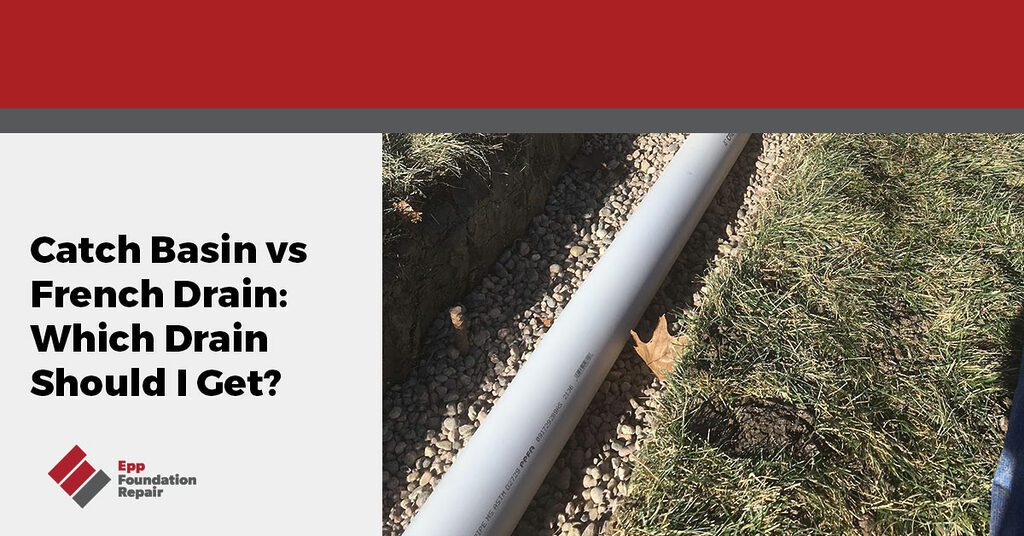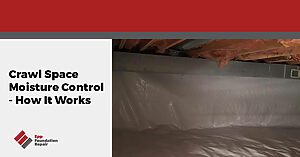Choosing a drainage system for your yard may seem confusing. Two popular solutions are catch basin drains and French drains. By understanding how these systems work, their primary purposes, their drawbacks, and how to understand what your yard needs, you can pick the best system for your property.
What Is a Catch Basin Drain?
A catch basin drain, also known as a storm drain, is a critical component of a drainage system designed to manage surface water runoff and prevent flooding. It is typically a rectangular or round underground structure with a grate or ground-level opening to collect rainwater. The catch basin is connected to a network of pipes that channel the collected water to a designated discharge point, such as a nearby stream, river, retention pond, or municipal storm sewer system.
Key features of a catch basin drain include:
- Opening – The top of the catch basin features a grate or opening that allows surface water to enter the drainage system but prevents debris from clogging the drain.
- Basin – Below the grate is a basin or sump where debris and pollutants settle from the collected water. The separation prevents clogging and maintains the efficiency of the drainage system.
- Outlet Pipe – The basin is connected to an outlet pipe discharging the water at a suitable location.
What Is the Purpose of a Catch Basin Drain?
In residential settings, a catch basin drain’s primary function is to manage surface water runoff around the property and prevent flooding, protecting the home’s foundation and surrounding structures. The primary purposes of a home catch basin drain are:
- Surface Water Management – It collects water runoff and snowmelt to prevent the water from accumulating on hard surfaces like driveways and patios. A catch basin helps prevent flooding of low-lying areas on the property, such as basements, crawl spaces, and yards.
- Erosion Control – Excessive surface water runoff can cause soil erosion and lead to differential settlement of your foundation. A catch basin helps control erosion by capturing runoff and directing it away from vulnerable areas.
- Protecting the Foundation – Proper drainage around the home is essential for protecting the foundation from water-related damage, such as settling and cracking. A catch basin helps prevent water from pooling around the foundation.
What Are the Drawbacks of Catch Basin Drains?
Catch basins can become clogged with debris and sediment over time, reducing effectiveness. Regular cleaning and maintenance are necessary to ensure proper functioning.
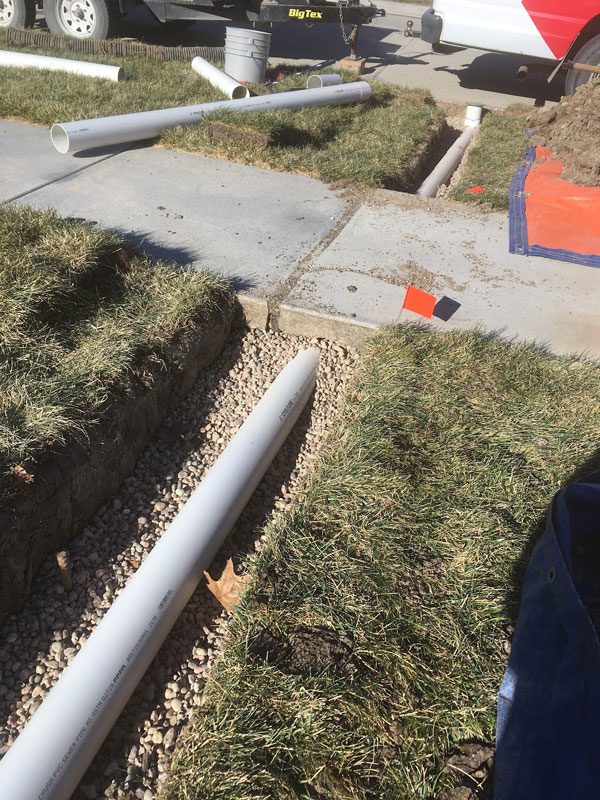
It is also important to note that catch basins can capture pollutants and chemicals from your yard or driveway and contaminate downstream water bodies or groundwater sources. Hence, it is critical to ensure appropriate filtration or treatment to mitigate this risk.
Installing catch basin drains requires excavation and underground piping by qualified professionals to ensure optimal performance and longevity. As a result, installation can be labor-intensive and costly. Catch basins also have a limited storage capacity, and during periods of intense runoff, they may become overwhelmed, leading to temporary flooding or water backup. Proper sizing and placement of catch basins are essential to mitigate this risk.
What Is a French Drain?
A French drain is an underground drainage system designed to manage surface and groundwater runoff and prevent water accumulation around your home and yard. It consists of a trench filled with gravel or rock and a perforated pipe that redirects water away from the area of concern.
Here’s how a French drain typically works and its components:
- Trench – A trench is excavated along the desired drainage path. The trench is usually sloped to ensure proper water flow and can vary in depth and width depending on the specific drainage needs and site conditions.
- Perforated Pipe – A perforated pipe, usually made of PVC or corrugated plastic, is placed at the bottom of the trench. The pipe is perforated with evenly spaced holes or slots to allow water to enter and be carried away from the area.
- Gravel – The trench is filled with gravel surrounding the perforated pipe. The gravel provides a porous medium through which water can flow freely, preventing soil from clogging the pipe.
- Permeable Fabric – In some cases, a layer of permeable fabric may be placed around the perforated pipe and gravel to help filter out sediment and prevent clogging.
- Discharge Point – The perforated pipe directs water collected in the trench to a designated discharge point, such as a storm drain, dry well, or a low-lying area where the water can safely drain away from the property.
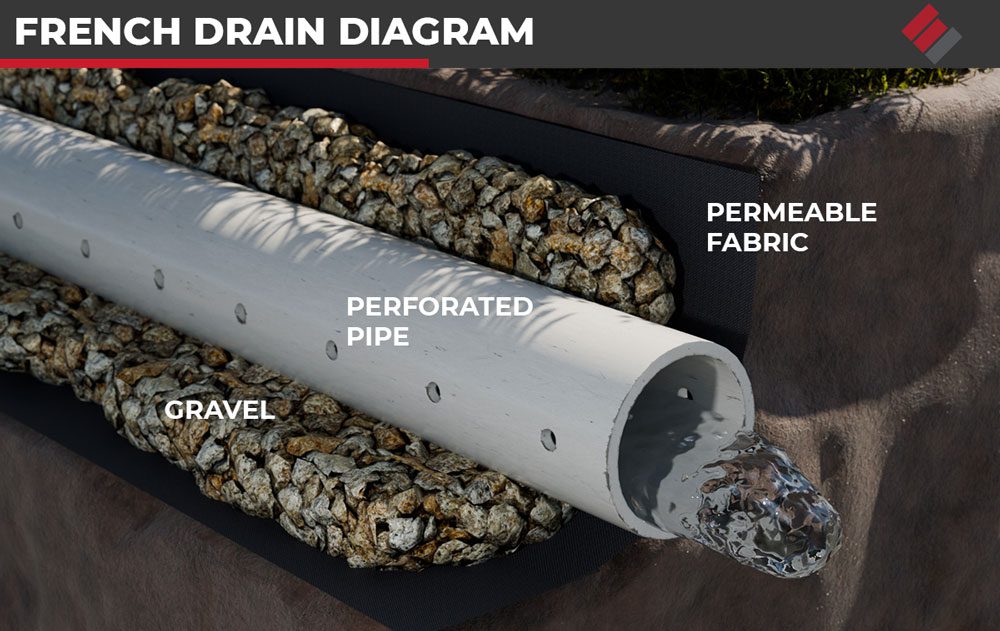
What Is the Purpose of a French Drain?
The purpose of a French drain is to effectively manage surface water runoff and groundwater infiltration, particularly in areas prone to water accumulation, flooding, or soil erosion. French drains are commonly used around the perimeter of your foundation or in landscaping projects to help control water flow and protect them from water-related damage.
Key benefits of French drains include:
- Protecting Foundation – Excess water around the foundation can lead to soil erosion, settlement, and structural damage over time. French drains help keep the soil around the foundation dry by intercepting and diverting water away from the home.
- Controlling Soil Erosion – French drains prevent water from washing away topsoil and landscaping features, maintaining the stability and aesthetic appeal of the property.
- Improving Yard Drainage – Poor drainage can result in a soggy yard. French drains help improve yard drainage by efficiently removing excess water from the soil.
What Are the Drawbacks of French Drains?
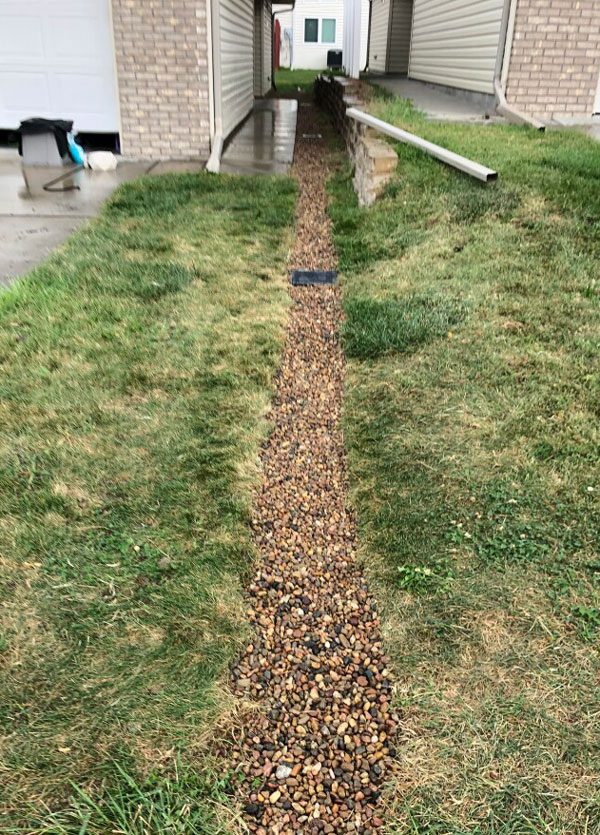
Installing a French drain can be labor-intensive and may require excavation of trenches around the home’s perimeter or yard. This process can be disruptive and time-consuming for some homeowners, as well as cause a significant installation cost. Some also find that the presence of the French drain detracts from the overall aesthetics of the property. However, careful planning and landscaping can seamlessly integrate the drain into the surroundings.
French drains also require regular maintenance to ensure optimal performance, although usually not as often as catch basin drains. French drains have a finite capacity for collecting and redirecting water away from the property. During heavy rainfall events or periods of intense runoff, the drain may become overwhelmed, leading to temporary flooding or water backup. Proper sizing and design of the French drain system are essential to minimize this risk. French drains may also capture pollutants like catch basins, so appropriate filtration or treatment is imperative to protect water bodies and groundwater sources.
How Do I Decide Which Drainage System to Get?
Deciding between a catch basin and a French drain depends on several factors, including the specific drainage needs of your property, site conditions, and personal preferences. Here are some considerations to help you determine which option is best suited for your situation:
- Surface Water vs. Groundwater – Determine whether the drainage issue primarily involves surface water runoff or groundwater infiltration. If you’re dealing with surface water runoff, a catch basin may be more appropriate, especially since it can handle larger amounts of runoff than a French drain system. A French drain may be more effective if the problem involves groundwater seepage or soil saturation.
- Extent of Drainage Area – Assess the size and extent of the drainage area that needs to be addressed. Catch basins are typically used in specific locations to capture water runoff, while French drains are often installed along the perimeter of your foundation to intercept and redirect groundwater.
- Soil Type – Consider the soil type of your property. French drains are effective in various soil types, including clay, sand, and loam. Catch basin drains may be more suitable for areas with compacted or poorly draining soil where surface water tends to accumulate.
- Site Accessibility – Evaluate the accessibility of the site where the drainage system will be installed. Catch basins require excavation and underground piping, which may be more challenging in areas with limited access or existing landscaping features. French drains also require trenching but may be easier to install in certain situations.
- Aesthetic Preferences – Catch basins are more visible above ground and may detract from the overall aesthetics of the landscape, with multiple metal grates spread throughout the property. French drains are typically installed underground and may be less intrusive, especially if integrated into the property’s landscaping.
Ultimately, the best choice between a catch basin and a French drain depends on your specific drainage needs and desires. Some homeowners have opted to install both drainage systems to maximize water management. Consulting with a qualified professional can help you assess your options and determine the most appropriate solution.
Are you curious about other drainage options and how to protect your foundation from water damage? Watch this video:
If you are concerned about yard drainage and want to protect your home’s foundation, schedule a free consultation with us today. Our experts will review various drainage options and other ways to protect your property. We service areas in Nebraska, Iowa, Kansas, and Missouri.

